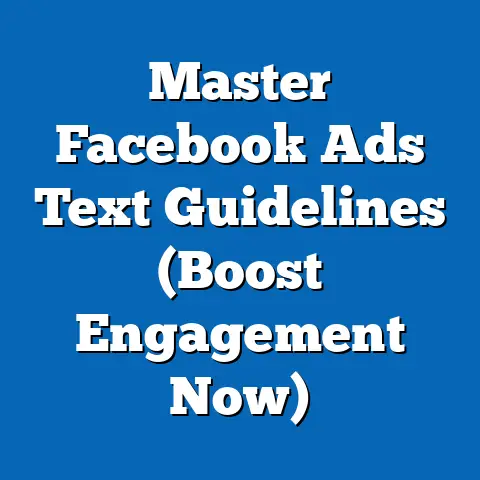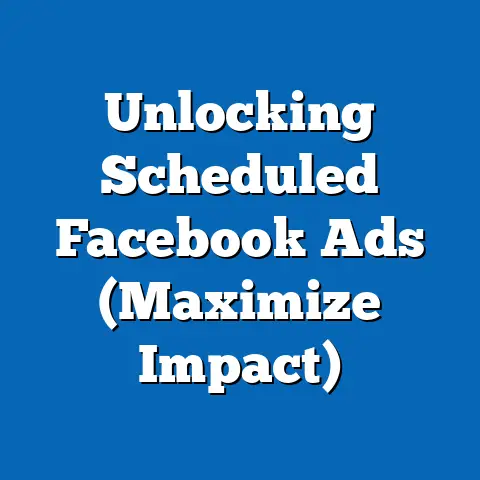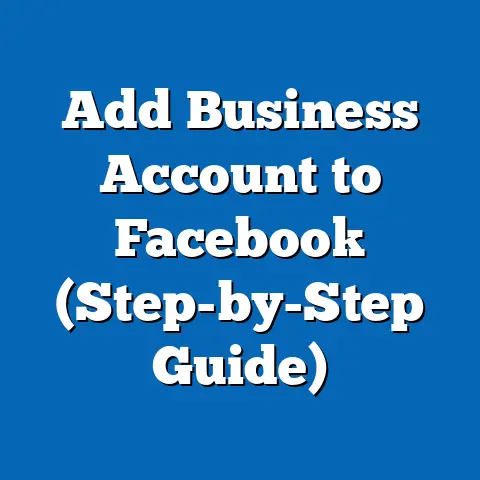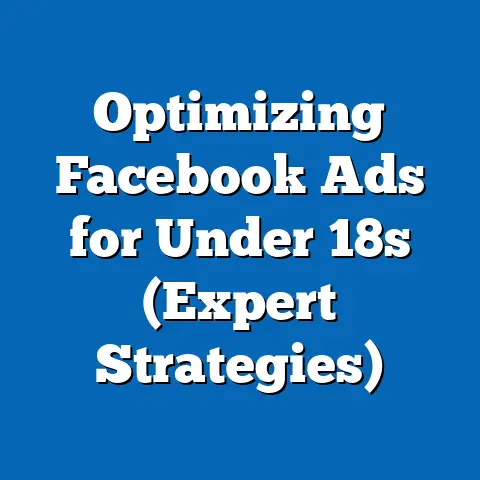Mastering Facebook Ads Cost for Healthcare (Pro Insights)
As a digital marketing specialist, I’ve seen firsthand how the healthcare industry juggles a million responsibilities. From tending to patients and tackling administrative tasks to staying current with medical advancements, marketing often takes a backseat. But in today’s competitive landscape, effective advertising is no longer optional; it’s essential. That’s where Facebook Ads come in, offering a powerful platform to connect with potential patients and build a thriving practice.
1. Understanding Facebook Ads for Healthcare
Facebook Ads are targeted advertisements displayed to users on the Facebook platform, including its associated platforms like Instagram. For the healthcare industry, this presents a unique opportunity. Think about it: millions of people are on Facebook every day, seeking information, connecting with friends and family, and yes, even researching healthcare options.
According to Pew Research Center, approximately 69% of U.S. adults use Facebook, making it one of the most widely used social media platforms. This broad reach allows healthcare providers to target specific demographics, interests, and even geographic locations, ensuring that your message reaches the people who need it most.
For example, a pediatric dentist could target parents in a specific zip code with ads promoting children’s dental hygiene. Or, a cardiology practice could target adults aged 50+ interested in heart health and living in a particular region.
However, advertising healthcare services on Facebook comes with its own set of challenges. Regulatory considerations, such as HIPAA compliance, are paramount. Privacy concerns must be addressed transparently and ethically. And the messaging needs to be sensitive and respectful, especially when dealing with sensitive health topics.
Key Takeaway: Facebook Ads offer a powerful tool for healthcare providers to reach a vast and targeted audience. However, it’s crucial to navigate the platform with an understanding of its unique challenges and ethical considerations.
2. The Importance of Cost Management in Facebook Advertising
Why is cost management so crucial in Facebook advertising for healthcare? Well, let’s be honest, budgets are often tight in the healthcare sector. Every dollar spent on marketing needs to deliver a tangible return.
Understanding and managing your Facebook Ads costs allows you to maximize your reach, optimize your campaigns, and ultimately, acquire more patients or clients. Failing to do so can lead to wasted ad spend and disappointing results.
Here are some key terms you need to understand:
- Cost Per Click (CPC): The amount you pay each time someone clicks on your ad.
- Cost Per Impression (CPM): The amount you pay for every 1,000 times your ad is displayed.
- Return on Ad Spend (ROAS): The revenue generated for every dollar spent on advertising.
Effective cost management involves understanding how these metrics work and optimizing your campaigns to achieve the best possible ROAS. For example, by carefully targeting your audience and crafting compelling ad copy, you can lower your CPC and CPM, resulting in more clicks and impressions for the same budget.
Key Takeaway: Effective cost management is essential for maximizing the impact of your Facebook Ads budget and achieving a positive return on investment.
3. Pricing Structure of Facebook Ads
Facebook Ads operate on an auction-based system. This means that your ad competes with other ads targeting the same audience. The price you pay depends on several factors, including your bid, the relevance of your ad, and the competition.
Here’s how it works:
- Bidding: You set a bid, which is the maximum amount you’re willing to pay for a click or impression.
- Auction: Facebook runs an auction to determine which ads will be displayed.
- Ad Ranking: Facebook considers several factors, including your bid, ad quality, and expected engagement, to rank ads.
- Winning Bid: The winning ad is displayed, and you pay the winning bid price.
Several factors influence ad costs in the healthcare niche:
- Target Audience: Highly specific and niche audiences tend to be more expensive to target.
- Ad Placement: Different ad placements (e.g., Facebook News Feed, Instagram Stories) have varying costs.
- Competition: Highly competitive keywords and audiences drive up costs.
Setting a budget that aligns with your marketing goals is crucial. Start by defining your objectives (e.g., lead generation, appointment bookings, website traffic) and then allocate a budget that allows you to test different targeting options and ad creatives.
I usually recommend starting with a smaller budget and gradually increasing it as you optimize your campaigns. This allows you to learn what works best for your audience without risking a significant amount of money upfront.
Key Takeaway: Understanding the auction-based system and the factors that influence ad costs is essential for setting a realistic budget and optimizing your campaigns.
4. Strategies for Reducing Facebook Ads Costs
Now, let’s dive into some actionable strategies for reducing your Facebook Ads costs without sacrificing ad quality:
-
Refine Your Targeting: One of the most effective ways to reduce costs is to refine your targeting options. Facebook offers a variety of targeting options, including:
- Geographic Targeting: Target people based on their location. This is particularly useful for healthcare providers who serve a local community.
- Interest Targeting: Target people based on their interests and hobbies. For example, you could target people interested in “healthy living” or “preventative care.”
- Demographic Targeting: Target people based on their age, gender, education, and other demographic factors.
- Lookalike Audiences: Create audiences that are similar to your existing customers or website visitors. This is a powerful way to reach new people who are likely to be interested in your services.
-
Improve Ad Relevance: Facebook rewards ads that are relevant to the audience. The higher your ad relevance score, the lower your costs will be. To improve ad relevance:
-
Create Compelling Ad Copy: Write clear, concise, and engaging ad copy that speaks directly to your target audience.
- Use High-Quality Visuals: Use eye-catching images or videos that are relevant to your message.
- Test Different Ad Creatives: Experiment with different ad copy, visuals, and calls to action to see what resonates best with your audience.
- Optimize Ad Placement: Test different ad placements to see which ones deliver the best results at the lowest cost. For example, you might find that ads in the Facebook News Feed perform better than ads in the right column.
Refine Your Targeting: One of the most effective ways to reduce costs is to refine your targeting options. Facebook offers a variety of targeting options, including:
- Geographic Targeting: Target people based on their location. This is particularly useful for healthcare providers who serve a local community.
- Interest Targeting: Target people based on their interests and hobbies. For example, you could target people interested in “healthy living” or “preventative care.”
- Demographic Targeting: Target people based on their age, gender, education, and other demographic factors.
- Lookalike Audiences: Create audiences that are similar to your existing customers or website visitors. This is a powerful way to reach new people who are likely to be interested in your services.
-
Improve Ad Relevance: Facebook rewards ads that are relevant to the audience. The higher your ad relevance score, the lower your costs will be. To improve ad relevance:
-
Create Compelling Ad Copy: Write clear, concise, and engaging ad copy that speaks directly to your target audience.
- Use High-Quality Visuals: Use eye-catching images or videos that are relevant to your message.
- Test Different Ad Creatives: Experiment with different ad copy, visuals, and calls to action to see what resonates best with your audience.
- Optimize Ad Placement: Test different ad placements to see which ones deliver the best results at the lowest cost. For example, you might find that ads in the Facebook News Feed perform better than ads in the right column.
Improve Ad Relevance: Facebook rewards ads that are relevant to the audience. The higher your ad relevance score, the lower your costs will be. To improve ad relevance:
Create Compelling Ad Copy: Write clear, concise, and engaging ad copy that speaks directly to your target audience.
Remember, A/B testing is your friend. I can’t stress this enough! Regularly test different ad creatives, targeting options, and placements to identify the most cost-effective strategies.
Key Takeaway: By refining your targeting, improving ad relevance, and optimizing ad placement, you can significantly reduce your Facebook Ads costs and improve your ROI.
5. Measuring Success and Adjusting Strategies
Measuring the success of your Facebook Ads campaigns is crucial for understanding what’s working and what’s not. Here are some key performance indicators (KPIs) that healthcare advertisers should track:
- Click-Through Rate (CTR): The percentage of people who see your ad and click on it. A high CTR indicates that your ad is relevant and engaging.
- Conversion Rate: The percentage of people who take a desired action after clicking on your ad (e.g., filling out a form, booking an appointment).
- Cost Per Acquisition (CPA): The cost of acquiring a new customer or patient through your Facebook Ads campaign.
- Return on Ad Spend (ROAS): The revenue generated for every dollar spent on advertising.
Interpreting Facebook Ads analytics is essential for making informed decisions about budget allocation and ad adjustments. For example, if you notice that your CPA is too high, you might need to refine your targeting or improve your ad relevance.
Let me share a quick story: I worked with a dental clinic that was struggling to generate new patient leads through Facebook Ads. After analyzing their data, we discovered that their targeting was too broad and their ad copy was not resonating with their target audience. By refining their targeting to focus on specific demographics and interests, and by crafting more compelling ad copy that highlighted the benefits of their services, we were able to reduce their CPA by 50% and significantly increase their lead generation.
Key Takeaway: Tracking key performance indicators and interpreting Facebook Ads analytics is essential for optimizing your campaigns and achieving your marketing goals.
6. Advanced Techniques for Mastering Facebook Ads
Once you have a solid understanding of the basics, you can explore some advanced techniques for mastering Facebook Ads:
- Retargeting: Retargeting involves showing ads to people who have previously interacted with your website or Facebook page. This is a powerful way to re-engage potential customers who have already shown an interest in your services.
- For instance, you could retarget visitors who viewed a specific service page on your website or who abandoned a form without completing it.
- Facebook Pixel: The Facebook Pixel is a small piece of code that you can install on your website to track conversions and optimize your ad spend.
- The Pixel allows you to track which ads are driving the most conversions and to create custom audiences based on website behavior.
- A/B Testing: A/B testing involves testing different versions of your ads to see which one performs best.
- You can test different ad copy, visuals, calls to action, and targeting options to identify the most effective strategies.
- For instance, you could retarget visitors who viewed a specific service page on your website or who abandoned a form without completing it.
- The Pixel allows you to track which ads are driving the most conversions and to create custom audiences based on website behavior.
- You can test different ad copy, visuals, calls to action, and targeting options to identify the most effective strategies.
I’ve found that using a combination of these advanced techniques can significantly improve the performance of your Facebook Ads campaigns and maximize your ROI.
Key Takeaway: Advanced techniques like retargeting, Facebook Pixel, and A/B testing can help you take your Facebook Ads campaigns to the next level and achieve even better results.
Conclusion
Mastering Facebook Ads costs is essential for the success of any healthcare marketing strategy. By understanding the platform, implementing effective cost management strategies, and continuously optimizing your campaigns, you can reach your target audience, acquire new patients, and ultimately, enhance your practice’s success.
Don’t be intimidated by the complexities of Facebook Ads. With the right insights and approaches, success is within reach. Take the actionable steps outlined in this guide, and start mastering your Facebook Ads strategy today! I know you can do it!






